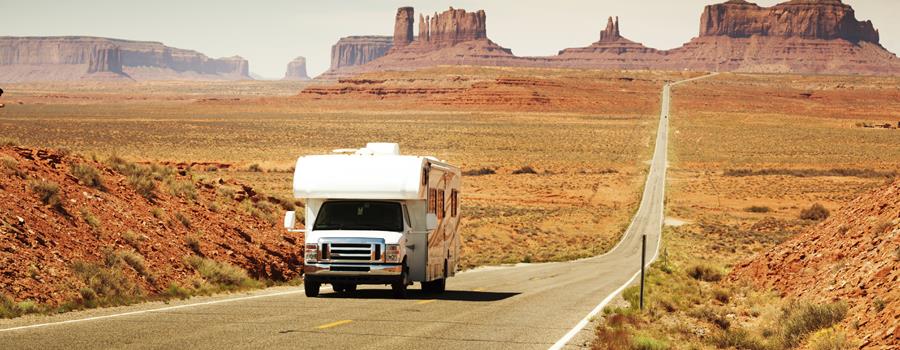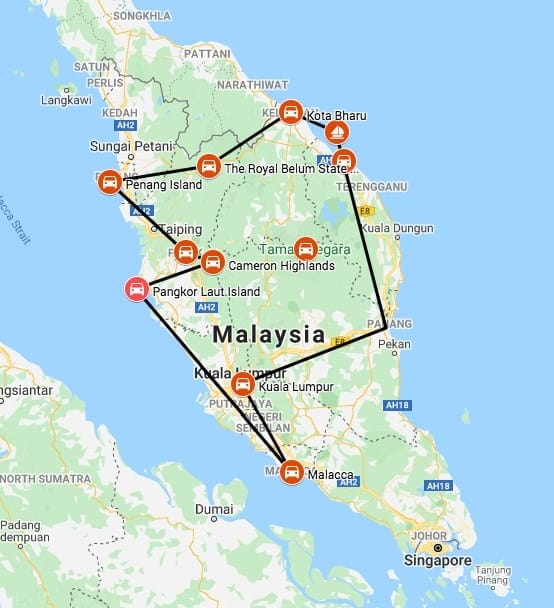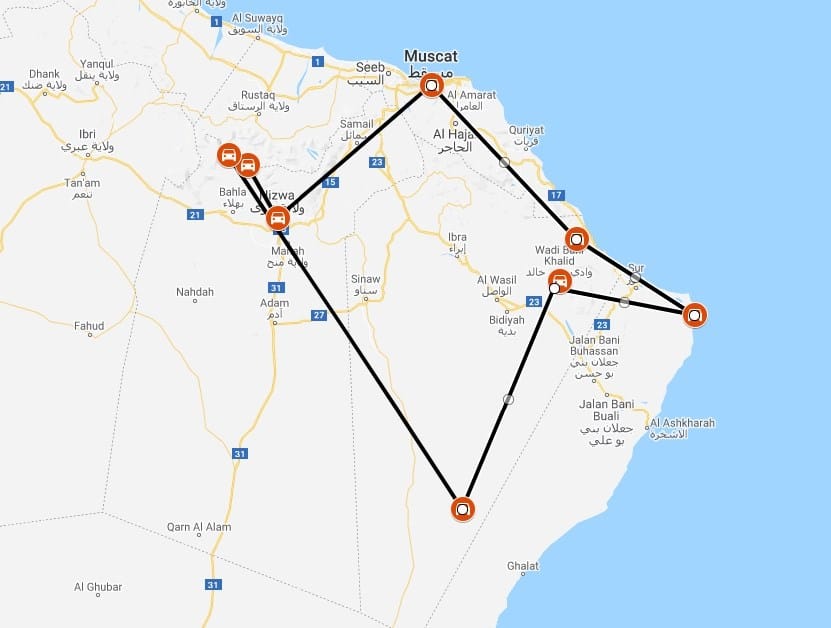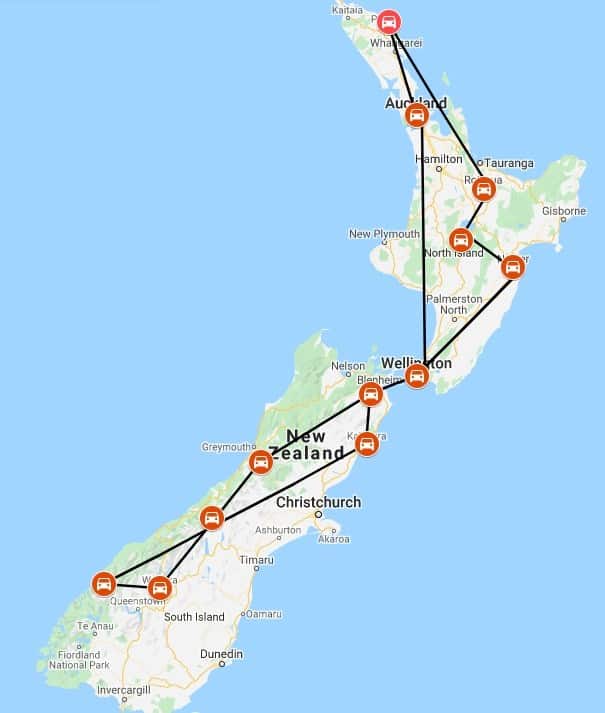
Often when we travel it can be a case of hopping quickly from place to place, ticking off as many of the major sightseeing attractions as possible in our limited time. But if you fancy an experience that feels a bit less hurried, what better way to get under the skin of a foreign land than to take to the open road on a self-drive (or fly-drive) holiday?
Imagine being able to really experience those terrific landscapes close up, stopping to enjoy that unexpected view anytime you like, pulling over for coffee at a little cafe or grabbing some local fruit for the journey from a roadside stall. With a great view from your window, you’ll get to see more of the country than you would taking an internal flight between centres, with the added bonus of avoiding the downtime involved in getting to and from airports and the checking in process. For families of all ages, the flexibility to travel at your own pace between accommodations makes for a more relaxing holiday.
Fly-drive holidays have long been synonymous with the USA. All those straight, long roads traversing the vast landscapes make it a natural fit, with the historic Route 66 being the all time classic American road trip. But with the advent of SatNav systems and mobile phones allaying the fears of getting stranded in the middle of nowhere, the potential for self-drive holidays has really opened up.
Read on to discover three totally different destinations that have good roads, good vehicles and the scenery to match for the perfect road trip. Pop your luggage in the boot, select your playlist and get off the tourist trail. Who knows what you might stumble across.
1. Multicultural Malaysia

Driving on the left is a legacy of having been a former British colony, so you’re off to a head start on a self-drive holiday to Malaysia.
The North-South Expressway makes travelling the length of the country easy and the road network in general is good, connecting towns and villages throughout the country. Aside from Kuala Lumpur in rush hour, roads also tend to be quiet and easy to navigate. Hire cars are good quality and as an oil producing country, petrol stations are frequent and you’ll be pleasantly surprised by the price.
Peninsula Malaysia is so diverse both in terms of geography and culture that a self drive holiday is quite simply the best way to get to experience it all. With tropical islands, white sandy beaches, coral reefs, UNESCO protected cities, ancient primary rainforest, highland tea plantations, exciting Capital and fabulous food, Malaysia has it all. Once central to the spice trade route, Malaysia is a melting pot of influences from the Chinese, Indian and Muslim merchants, creating a rich culture and culinary heritage still very much evident today.
Itinerary Highlights
Kuala Lumpur: The capital is a vibrant, modern city still in touch with its traditional roots making it a fascinating, fun place to start your journey. Here historic temples and mosques rub shoulders with contemporary towers and glitzy shopping malls and traditional markets have equal place. KL‘s dining scene is a non-stop feast from traditional hawker stalls, old school Chinese and Indian restaurants to wi-fi enabled cafes with great cappuccinos, rooftop cocktail bars, elegant French-style cuisine and everything in between.
Malacca: A compact city with Sumatran, Portuguese, Dutch and British colonial influences which has been designated a UNESCO world heritage site. Learn more about the Peranakan culture, take a rickshaw ride and visit the Jonker Street night market. It’s also a haven for foodies with many hawker food stalls and good restaurants offering authentic Malay cuisine.
Pangkor Laut: Leave your car in the carpark and take the speedboat across to Pangkor Laut resort. Situated on it’s very own tropical island off the west coast come and be pampered in relaxed luxurious style. The perfect white sandy beach destination if travelling between November and April.
Cameron Highlands: Take the scenic, winding road up into the cooler climes of this colonial hill station. Visit the tea plantations and strawberry farms, hike in the unspoiled landscape and return for a very British afternoon tea. You might even fancy a spot of golf.
Ipoh: A good overnight stop on your way to Penang. Another foodie city and chock full of colonial architecture. With the benefit of a car you can also visit the impressive temple caves in the surrounding hills.
Penang: This island offers lots of variety from the bustling UNESCO capital of George Town famous for its food and quaint local villages to great beaches and the Penang National Park offering great jungle trails. A complete snapshot of Malaysia in one!
Rainforest: At 135 million years old, the virgin rainforests of Malaysia are the world’s oldest. There are two top choices here. Taman Negara is a 4343 square-kilometre protected area with jungle treks, canopy walks and caves. Visit a tribal village to learn about indigenous life in the jungle. Further North is The Royal Belum State Park, one of Peninsula Malaysia’s largest tracts of virgin jungle. Home to tapirs, tigers, sun bears, panthers and the endangered sumatran rhino, 10 species of hornbill and the rare rafflesia flower (at 1m in diameter it is the world’s largest (and stinkiest!) bloom).
East Coast: If you are travelling between April and October, you will want to head over to the East Coast for the weather. Kota Bharu in the north is a friendly city with superb food, great crafts and vibrant night market. From here you can hop across to the idyllic Perhentian Islands for diving, snorkelling, turtles and the opportunity to get involved in some eco volunteering. Then enjoy cruising south down the palm fringed coast road passing unspoilt kampung and traditional Malay fishing villages. You’ll find plenty of places for rest stops. Penarik is a charming spot for a taste of coastal Malaysian culture and by night you can take a boat trip down the river through the magical Penarik Firefly Sanctuary.
2. Mountains and Desert in Oman

If you’re looking for a sunny escape with a practical flight time, Oman offers sea, sand, incredible sights. The Middle East’s best-kept secret, Oman combines unspoiled desert landscapes with a chance to experience authentic Arabian culture. You will discover a safe, friendly country with pristine beaches, golden deserts and mountain scenery, as well as traditional villages where goats roam freely through the narrow streets.
It has an excellent road network (with English signage) and very little traffic making it ideal for a self-drive holiday taken at your own pace. Another oil producing country, petrol is cheap and plentiful. Hiring a 4×4 is a popular option here in order to enjoy exploring Oman’s off road mountain tracks and for a bit of fun in the sand dunes.
Accommodation outside Muscat tends to be limited in choice but as tourism grows this is changing. Standards range from simple to 5 star. Staying at the Anantara Al Jabal Al Akhdar Resort is an excellent opportunity to experience an Omani take on a luxury mountain retreat.
Itinerary Highlights
Muscat: This is the logical place to start your trip and worth spending a couple of nights here. Visit the Grand Mosque which is one of the world’s largest with capacity for 20,000 people. Stroll along the Mutrah Corniche on the seafront before sunset and admire the amazing mountainous backdrop and enjoy a wander around the Mutrah souq.
Nizwah: It’s an easy drive up through the Hajar mountains to Nizwah. One of the oldest cities in Oman, Nizwah is a thoroughly enjoyable place to while away a few days, with a string of attractions including the magnificent Nizwah Fort built to defend this strategic location, fine souks and a famous goat market. You can also reach Jabrin Fort from here, recently restored and one of the best to visit.
Jebel Akhdar: You will need your 4×4 to reach the top here. The Green Mountain, centred on the Saiq Plateau, is so called for its terraces where apricot, pomegranate and walnut trees flourish along with the damask roses used for rose water, a popular cooking ingredient. Experience the mountains’ panoramic views, small traditional villages and rose-water distilleries.
Jebel Shams: Drive up Oman’s highest mountain (3005m) and enjoy grand views down into the great chasm of Wadi Nakhr (also sometimes referred to as Wadi Ghul, to which it’s joined), and popularly known as the “Grand Canyon” of Oman. Make for Khateem, the starting point for the spectacular Balcony Walk (part of hiking route W6 and clearly waymarked with the usual red, white and yellow painted flags). The scenery here is some of the most dramatic anywhere in Oman with birds of prey riding the thermals.
Wahiba Sands: In the heart of eastern Oman, the Wahiba Sands is an ocean of regular dunes that seem to stretch out endlessly. The dunes are constantly moving — up to 10 m (33 ft) a year — making permanent roads impossible. Instead, you’ll find just a few tracks created by visitors who come for the desert camps, and by a handful of Oman’s Bedouin tribes. Spend the night in a Bedouin tent, marvel at the starry sky and watch sunset and sunrise from the top of a dune.
Wild Wadi Swimming: If it’s the rainy season there may be enough water in the wadis for a cooling swim. Wadi Bani Khalid is one of the most popular but quieter if you head for trickier to get to upper pools. It’s a pretty spot complete with date palms and mountain backdrop. Wadi Shab requires a short boat trip across the river and a scenic 45 minute hike to the permitted swimming area. There are three pools ending with a cave complete with a waterfall for a magical experience if you’re feeling adventurous.
Ras al Jinz: Approximately 20,000 turtles come each year to some of Oman’s beaches, especially the eastern ones, to lay 50,000 to 60,000 eggs. Ras Al Jinz is a small sandy bay where greenback turtles come ashore to nest all year round (though the principal nesting season is July to September). You need a permit to visit the beach at night. Visits are undertaken in the company of a guide who ensures minimal disruption to the huge turtles as they dig their nests and lay their eggs. You should also be able to see some of the hatchlings making their precarious way down to the ocean.
3. Natural Beauty in New Zealand

A self-drive tour through New Zealand is a trip of a lifetime. Whether you fancy an epic journey across both islands or spending time discovering every corner of one, driving is really the best way to see the country and its spectacular scenery. Some of the coastal roads take you remarkably close to the water’s edge where you can spot seals sunning themselves on the rocks, while a drive through magnificent native forest feels as though you are entering a fairy kingdom. You can do it all at your own pace with plenty of flexibility to explore, stopping to capture photos whenever the urge strikes and venturing to places you might not get to see otherwise.
Driving is on the left, traffic volumes are comparably low, roads are well-maintained and New Zealanders tend to be considerate drivers. There are few motorways, most roads being two-way with one lane in each direction and the mountain roads can get steep and windy. This can make travel times a bit slower but the perfect tempo for taking in your amazing surroundings. Petrol prices are similar to UK prices.
Whether your vehicle of choice is a car, a campervan, or even motorcycle, New Zealand is a fantastic place to explore by road. Accommodation choices include everything from luxurious boutique lodges to simple inns, family-run bed & breakfasts and rural homestays.
North Island is where most of the population lives; South Island, being closer to Antarctica, is cooler. The South Island is arguably the more scenic of the two islands with its lakes, mountains, fjords and glaciers but the North Island offers plenty too – the Waikato countryside, Rotorua the Maori cultural heart of the country, the sparkling sub-tropical Northlands and Wellington, the vibrant capital. You can’t really make a wrong turn!
North island Highlights.
Auckland: With its international airport, Auckland makes a good start point for your journey. Auckland is New Zealand’s largest city and based around two harbours. Viaduct Harbour is a great setting for a stroll along the waterfront admiring the yachts, dining in style in world class restaurants or enjoying the great shopping and entertainment.
Take a day trip across to Waiheke Island just off the Auckland coast with 92 square kilometres of beautiful beaches, vineyards, olive groves, native bush and laid back seaside villages.
Bay of Islands: The Bay of Islands, on the northernmost tip of North Island, is a subtropical haven of ancient kauri forests, stunning coastlines and secluded, undeveloped coves that are perfect for exploring and water activities. Visit Waitangi Treaty Ground, New Zealand’s most important historic site where, in 1840, New Zealand’s founding document was signed.
Rotorua: Rotorua is in the very heart of the North Island of New Zealand. With a laid-back atmosphere, it’s the perfect place to recharge your batteries, connect with Maori culture, and get back to nature with a walk in the Redwood forests or tackling one of the oldest mountain biking networks in the world. Discover geysers and whizz down Lake Rotorua in a canoe or take a trip to the Hobbiton film set.
Tongariro National Park: Within the boundaries of the Park are three volcanoes making for some of New Zealand’s most contrasting and breath-taking landscapes. Discover some of the best ski and snowboarding runs in the country during the winter months, and in summer a network of tracks and huts provide a choice of superb walks, the most famous of which is the full day trek The Tongariro Alpine Crossing.
Hawkes Bay: Hawkes Bay is renowned for its Mediterranean climate with great wine and food to go with it so an ideal stopover to include in your itinerary. Take a guided tour of the wineries or cruise the Art Deco streets of Napier in an open topped 1930’s vintage car.
Wellington: Voted the “coolest little capital city” in the world by Lonely Planet, Wellington is the artistic and cultural capital of New Zealand. Foodies will adore Wellington with its rich drinking and dining scene which boasts more restaurants, cafes, and drinking establishments per capita than New York. The harbour is beautiful and the gateway to South Island from where the ferry takes 3 hours.
South Island Highlights
Marlborough Sounds: The Marlborough Sounds are a network of intricate waterways and river valleys that lead to sandy coves and sheltered inlets, best explored on foot or by boat or kayak, and a great place to enjoy some of New Zealand’s most magical scenery and wildlife. It is also the largest wine growing region of New Zealand famous for those crisp Sauvignon Blancs. Enjoy a cruise out on the sounds to catch fresh Greenlip mussels before sampling them, gently steamed and paired with local wine!
Kaikoura: The Kaikoura region is a dream for keen walkers and wildlife lovers who come to see whales, dolphins, albatross, penguins and fur seals in their natural habitat. Kaikoura actually means ‘Meal of Crayfish’ so you must make sure you pay a visit to one of the iconic roadside stalls to sample some of the area’s most famous seafood speciality.
Mount Cook National Park: Mount Cook National Park itself is home to New Zealand’s highest mountains, and some of the country’s most magnificent star gazing opportunities with its jaw droppingly clear night skies. It’s guaranteed you’ll be stopping at every bend to capture the incredible views on camera!
Milford Sound: Fiordland National Park is justifiably a World Heritage site and home to the breathtaking Milford and Doubtful Sounds, the two largest of the 14 fiords. The drive on the road into Milford is regarded as one of the world’s finest. For a real once in a lifetime experience, take an overnight trip on a cruiser to view the fiord’s spectacular waterfalls, rainforest, mountains and wildlife close up.
Wanaka: Wanaka is Queenstown’s quieter, smaller sister with a more relaxed and chilled out feel. People come for it’s incredible scenery and outstanding natural beauty, as well as being a great base for some unforgettable outdoor activities and experiences.
West Coast: Wild and rugged the West coast runs down the west side of the South island, from Westport to Greymouth, and has been voted as one of the top coastal drives in the world. Don’t miss the Fox and Franz Josef Glaciers. If you’re looking forward to watching BBC1’s The Luminaries starting on Sunday 21st June all about the West Coast gold rush of the 1870s, Hokitika will be worth a visit. Here you’ll find relics, museums, and historic buildings that record the hardship of that bygone age. It is also famous for its Jade or ‘greenstone’.
Abel Tasman: The only coastal national park in New Zealand, Abel Tasman National Park offers a magnificent coastline, miles of golden sandy beaches, and lagoons and verdant native bush. Attractions include sailing, cruising or kayaking crystal clear, turquoise waters around secluded bays, stopping off for a swim as you go –or walking the Abel Tasman Coastal track, through native bush, over limestone cliffs and along long sandy beaches.


